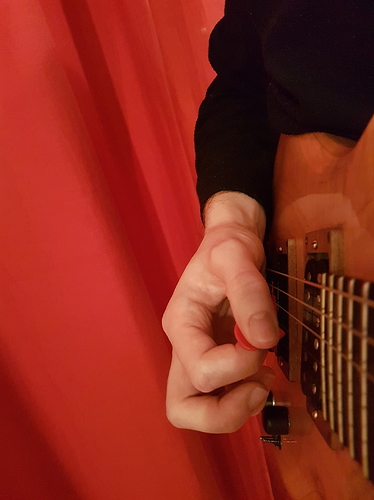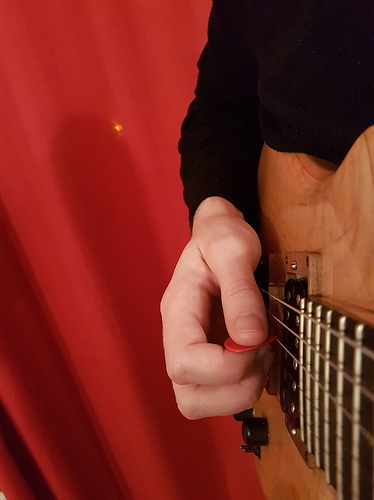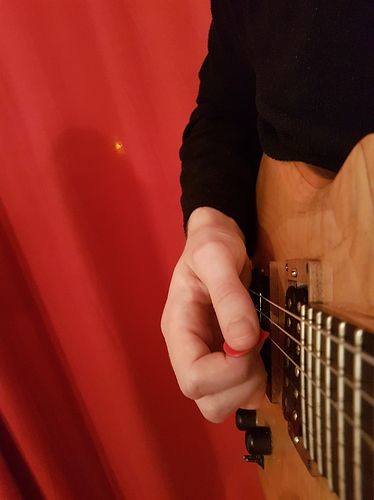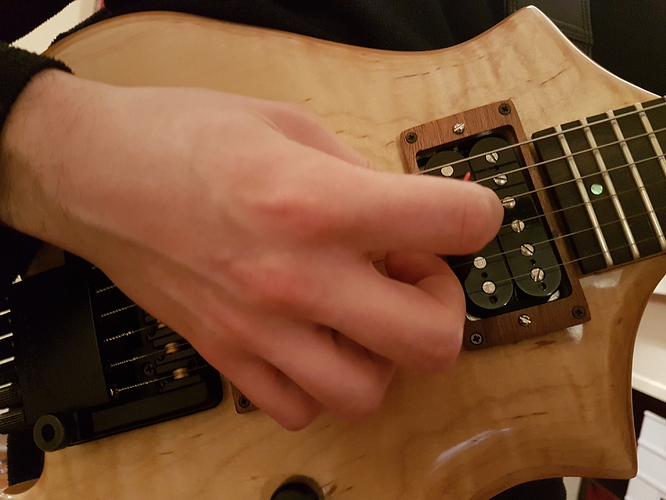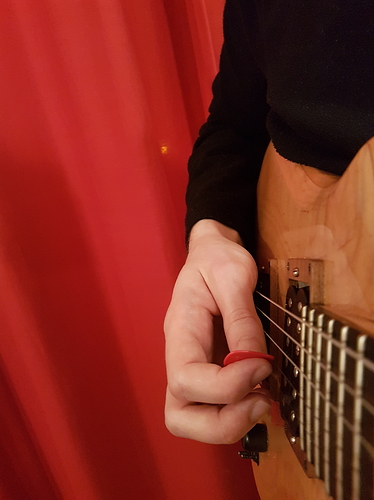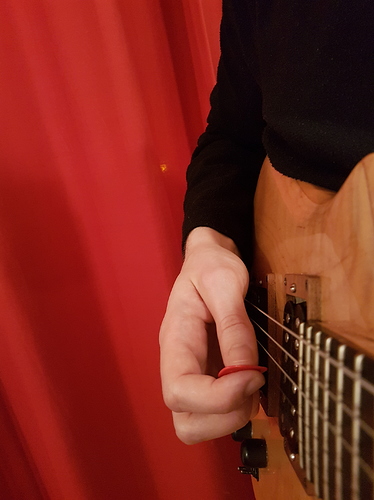In the last week I’ve tried to collect my thoughts regarding the different mechanics I use while playing. The intent was to categorize my fretting and picking hand positions and movements to better understand what the optimal way of playing different passages.
Concerning the picking hand, I recognize the following modes of picking in my playing, which feel distinct and have different strengths and weaknesses.
Mode 1:
This is the first mode of picking I developed, during my mid-teens when I was learning to play pieces by Paul Gilbert and Steve Morse with strict alternate picking.
This mode of picking is a primary neutral, 2-way pickslanting and crosspicking combination technique. The picking movement is primarily forearm rotation, with some wrist extension and flexion on the downstroke and upstroke (respectively). There is constant “thumb bump” and approximately 45 degrees of leading edge picking. When crosspicking, the movements are quite large. When playing scalar passages, pickslanting is introduced as required and movements become smaller, but is still a combination of forearm rotation and flexion and extension.
All strings lower than the string being played are damped with the flesh of the palm near the pisiform bone of the wrist. Higher strings are damped with the fretting hand.
In this mode, I’m using strict alternate picking (almost) exclusively. In fact, I feel like sweeping in this mode ruins my groove and rhythmic flow. The only time I break from strict alternate picking is to allow for consecutive outside string changes when playing string skipping licks.
There is a hard, percussive attack to the picked notes, as in Gilbert’s and Morse’s playing, which I can’t eliminate nor reduce very significantly. I have a large dynamic range and pinch harmonics are easy on downstrokes. I can reach Gilbert/Morse type speeds in this mode.
The hard attack does not blend well with hammers and pull-offs when playing legato. Sweeping string changes, as in pure DWPS licks feels strange, as does trying to incorporate any hybrid picking.
These issues are handled by changing my hand position slightly to facilitate my second picking mode.
Mode 2:
This is a 2-way pickslanting technique with greater facility for incorporating hybrid picking. There is a slight primary downward pickslant, which can be exaggerated. The degree of upward pickslanting I can implement is minimal.
I feel like picking movement is primarily wrist deviation, though I think there is some very slight rotation also. I can crosspick by introducing extension on a downstroke from the primary down position. There is much smaller degree of leading edge picking than in Mode 1, and a thumb bump is not noticeable.
The lower strings are damped by the flesh of the palm between the pisiform bone and the opponens. Higher strings are damped with the finger tips or damped by the fretting hand.
My capacity for strict alternate picking is reduced compared to Mode 1, but sweeping and hybrid picking feel much more natural. There is a softer, rounder attack to the picked notes that I can blend well with legato and hybrid picked notes.
I believe this is very similar to Marshall Harrison’s picking approach.
Mode 3:
This mode is a pure DWPS system, which is attained by tucking the finger tips of the picking hand from Mode 2 to allow for greater supination. I think this is almost exactly the Eric Johnson mode of picking. The greater degree of supination results in more edge picking than in Mode 2. I feel like the picking movement is pure wrist deviation when playing at speed.
The lower strings are damped primarily with the ulnar side of the palm. The flesh of the curled fingers touch the higher strings, damping the high strings.
It does what a downward pickslanting system does. The pick attack is just slightly harder than Mode 2; it’s articulate and I feel I have good dynamic range.
For some lines, I prefer to switch my pick grip so that the pick is held between the pad of the index finger and the thumb tip, which results is a severe degree of trailing edge picking.
This picture shows clearly shows that the degree of trailing edge picking is about 70 degrees! There is also very little pick depth available to me. The degree of edge picking and the shallow depth combined results in less resistance from the strings, so pickstrokes feel almost effortless. I cannot reliably execute pinch harmonics with this grip.
There are two further modes which use this grip.
Mode 4:
This is the loosest, most relaxed hand position I can adopt while holding a pick. I would describe this mode as a primary downward, 2 way pickslanting and crosspicking technique. I feel like this position has a lot in common with Mode 2, though my capacity for hybrid picking is slightly reduced (the picking hand pinky is less well aligned for this purpose than in Mode 2), sweeping is less comfortable and string damping feels less comprehensive. I feel like the movement mechanic is again primarily based on deviation, though I feel like there is a small amount of forearm rotation too. Again, I can crosspick by using extension on downstrokes.
Due to the pick depth and degree of edge picking, the tone is very round and the attack is quite soft. Hitting the strings harder fails to give the sharp, percussive attack of Mode 1.
Curling my fingertips inward to allow for greater supination, we arrive at the final mode of picking in my playing.
Mode 5:
This is a pure DWPS system. It feels very much like Mode 3, but with less exertion required on the pickstrokes. I feel like the movement mechanic is pure deviation, and I can execute this movement as fast as I can move my fretting hand. If you asked me to play descending sixes as fast as I possibly could, this would be the mode of picking I would use. I think this mode, along with Mode 4, is basically the approach to picking that Shawn Lane used.
I notice some common features to all modes. I don’t feel like I’m moving my fingers at all in any picking mode. In all modes, very little pressure is exerted into the guitar by the picking hand. Contact with the strings is for damping unwanted noise, not support. String tracking is primarily via elbow movement in all modes. Since all modes are almost floating, the picking hand is always highly mobile.
Any wrist extension on an upstroke feels completely wrong to me at even slow to medium speeds, which I believe explains why I never gravitated to a primary upward pickslanting system when crosspicking, as Molly Tuttle uses. I think I have a knack for motor learning, but I don’t seem to be able to internalize that type of movement. I think this also explains, in part, why I never had issues with stringhopping.
All of these modes are pretty sensitive to changes away from my preferred picks, which are the standard sized Dunlop Jazz IIIs (usually the EJ version, but I use Ultex for harder rock and acoustic playing). My technique suffers greatly if I try to use another style of pick.
I have been experimenting with the Steve Morse approach, with the 3-finger pick grip and rotation and flexion/extension combination mechanic, but this is still very muchin it’s infancy
Finally, I had been thinking about introducing an elbow based movement mechanic to complement one of these picking modes. I feel most comfortable attempting this in the same position as Mode 5. I can tremolo pick faster with the elbow movement in short bursts, but since I’m already keeping up with my fretting hand, I’m not really sure now what the benefit of practicing an elbow movement would be for me. The types of music I play don’t involve much tremolo picking.
Do you recognize distinct modes of picking in your playing, or do you rely on one single mode exclusively? If you use multiple modes, what are they and what benefits and drawbacks do you perceive in each mode? If not, why not? Are you staying focused on that mode of picking or are you trying to develop other modes? If you use multiple modes, do you recognize common traits between them?

